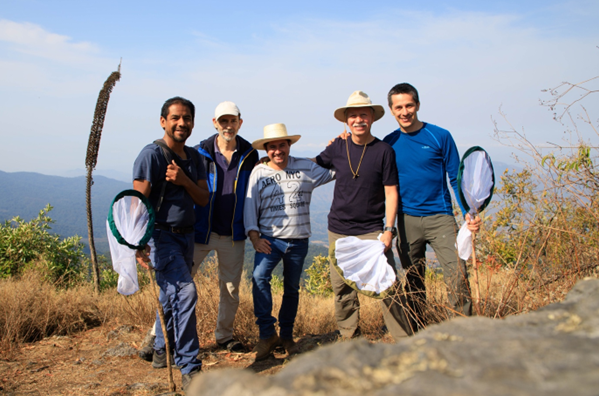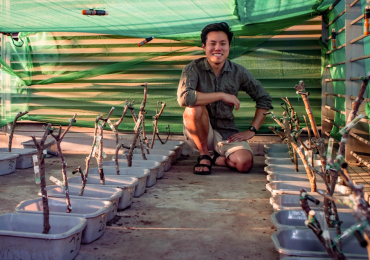In this week’s blog post, we’re learning all about buzz pollination between Bombus terrestris and Solanum rostratum! Author Mario Vallejo-Marín explains one of the most striking examples of evolutionary convergence in floral form – buzz pollinated flowers: “Gradual pollen release in a buzz-pollinated plant: Investigating pollen presentation theory under bee visitation”.
1. About the Paper
In this paper, we used nectarless, buzz pollinated flowers, and real bee pollinators to investigate how plants dose their pollen. We wanted to test the idea that buzz pollinated plants should release relatively small amounts of pollen even when a bee uses its best tricks (buzzing) to remove pollen grains.
Why does this matter?
Bees are greedy pollen collectors. And they should be, as their offspring depends solely on pollen as a source of protein. Without pollen to feed their larvae, no adult bees are produced. For plants, this poses a problem, as in order to use bees as pollen couriers to fertilise other plants, sometimes they have to pay in the precious currency of their own plant gametes. This is especially the case for the many thousands of plant species that do not produce nectar and instead rely exclusively on pollen to pay their match makers. Thus, a bee visiting a nectarless flower might benefit from taking as much pollen from it as it can, but for a plant it might be best not to let a single bee take all.
Limiting the amount of pollen that each bee removes can benefit the plant because bees that remove smaller amounts of pollen clean themselves less and leave more pollen available for pollinating other flowers. Theory predicts that plants should have evolved floral strategies that limit pollen removal by either presenting pollen in smaller packages or making it difficult to remove large amounts of pollen at once. In our paper, we set to test the idea that buzz pollinated plants act as effective pollen dispensing mechanisms using an experiment.
Why buzz pollination?
A buzz pollinated flower is like a treasure chest of pollen that keep most visitors away, but which can be opened by a bee’s buzz. This gave us the unique chance of connecting a complex bee behaviour (pollination buzzes) with an important functional phenomenon (the release of pollen from flowers).
Buzz pollination occurs when a bee uses powerful vibrations produced with their thoracic muscles to shake pollen grains out of flowers. Buzz pollinated plants have special types of pollen-carrying structures that keep pollen grains away from the direct touch of floral visitors. To remove pollen grains from these flowers, the bee needs to eject them somehow through very small openings at the anthers’ tip. Pollination buzzes are just the right tool for that job.
Main findings
After measuring more than 2,000 bee buzzes in 80 flowers, we showed that Solanum rostratum releases only 2-4% of the available pollen per second of buzzing. We estimated that on average a bee would need to buzz a flower for more than 25 seconds to extract half of the pollen it contains.
Buzzing flowers is very energetically costly, and elsewhere we have shown that it might in fact be among the most energy-demanding activities a bee does. Therefore, we conclude that buzz pollinated flowers are effective pollen dosing mechanisms even when faced with bees capable of producing powerful floral vibrations.
2. About the Research
Working with bees is lots of fun. Our experiment consisted of studying individual bumblebees visiting single flowers of Solanum rostratum. For the experiment, we connected a colony of Bombus terrestris to a flight arena and allowed it to visit a flower of Solanum rostratum, a spiny but beautiful plant with yellow buzz-pollinated flowers. The bee was allowed to visit the flower for different amounts of time. When a bee started buzzing the flower, you could see how pollen begun accumulating on its body. The bee would combine buzzing with cleaning its body and packing pollen in her pollen baskets, which quickly began to grow.
To measure buzzing effort, we took advantage of the unique sound produced by bees when buzzing flowers. These buzzing sounds have a typical high pitch that differs from the sound made when the bee flies. Using a microphone placed near the flower, we recorded the visit and then identified and quantified buzzing events in the recording. We then collected flowers and measured how much pollen was left by the bee. The data of pollen remaining and buzzing effort was used to build pollen dispensing curves, which show the rate at which pollen is removed from the flower.
One of my favourite things of working in this experiment was to spend time observing pollinating bumblebees. Although their buzz pollinating visits may appear quick and frantic, you soon begin noticing the little details that allow these bees to manipulate complex flowers in a kind of pollination dance that involves biting, shaking, turning and curling around the flower. It is then very satisfying to see a bee take off from the flower, covered by pollen, and start packing its bounty with rapid and coordinated movements.
Measuring pollen release from flowers is fiddly and time-consuming work. Our lab study takes advantage of a well-developed bumblebee-buzz pollinated plant system, but it would be very interesting to expand similar studies to other types of bees and buzz pollinated flowers. Buzz pollinated flowers are one of the most striking examples of evolutionary convergence in floral form (specialised tube-like structures that release pollen upon being vibrated), but there are many ways to being a buzz pollinated flower and the morphology of the floral tube and associated structures is highly variable. Future studies looking at how other buzz pollinated flowers dose their pollen when visited by other types of bees would help establishing the generality of our findings. With thousands of plant and bee species involved in buzz pollination around the World there are plenty of opportunities for studying this fascinating phenomenon.
3. About the Author
I am a Professor in Ecological Botany at Uppsala University, Sweden, where I have been for the last three years. Since my undergrad days in Mexico City, I have been interested in the interaction between plants and animals, particularly at the intersection between ecology and evolution. For the past few years, I have been spending much of my time thinking about the ecology, evolution, and biomechanics of buzz pollination. I came to this topic when observing bumblebees visiting flowers of Solanum during my PhD in North Carolina, USA. But I did not start to seriously investigate it until a chance visit brought an acoustic ecologist, Paul De Luca, to my lab, then in Scotland. Since then, I have been captivated by the interdisciplinarity of studying buzz pollination. I have found that you can use tools from many different fields from ethology to biophysics, from phylogenetics to muddy-boot field biology, and from botany to robotics, to study the simple questions of how and why bees buzz flowers. I really enjoy learning about new fields and collaborating with many friends and colleagues in the study of buzz pollination.
Being a biologist is lots of fun because no matter where you are you can always find some interesting biological twist or story, and sometimes even your garden or park might have a biological surprise for you. I feel lucky because many of the things I do in my job are the same that I want to do in my free time. My family is kind enough to understand that even during our holiday travels, we might take a small detour to find a particular plant, or bee, or hike to place with cool biology, and sometimes even do a small experiment in our garden.
More than barriers to progressing in my scientific career, I remember most the many opportunities and support I received along the way. From the small grants I got as an undergrad to help me focus on my research, to the opportunity to study abroad funded by the Mexican government, to the belief that people had in me when joining their labs or getting a job at their Universities, I count myself very lucky. I am not sure what piece of advice I would give to my younger self, because he probably would have ignored it anyway or done the exact opposite. I think that trying to find early on what you enjoy doing is helpful. For me, looking for a way to combine my interests with my job has brought me lots of satisfaction. But if academia had not worked out for me, then I would have tried to invent myself in some other field or occupation maybe writing, or photography, or engineering, or something like that. Regardless of your day job, biological wonders are never too far away.
Leave a comment





